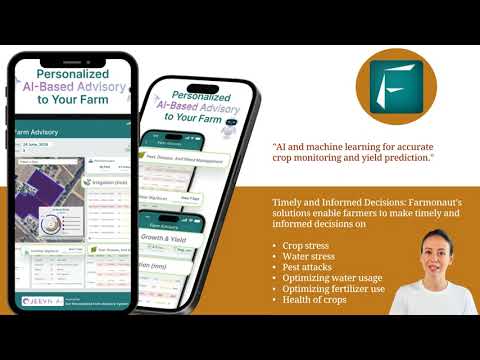Boost Your Farm’s Profitability: Precision Agriculture Strategies for Midwest Crop Management

“Precision agriculture can increase crop yields by up to 20% while reducing water usage by 30%.”
Welcome to our comprehensive guide on boosting your farm’s profitability through precision agriculture strategies tailored for Midwest crop management. As markets fluctuate and weather patterns shift, we at Farmonaut are committed to bringing you cutting-edge agtech solutions that optimize your field performance and enhance your bottom line. In this blog post, we’ll explore essential agricultural profitability strategies, farm financial management insights, and innovative approaches to sustainable farming practices that can transform your agricultural enterprise.
The Changing Landscape of Midwest Agriculture
The agricultural heartland of America, spanning states like Illinois, Indiana, Iowa, Michigan, Ohio, and Wisconsin, has long been the backbone of U.S. crop production. However, today’s farmers face unprecedented challenges:
- Fluctuating commodity prices
- Unpredictable weather patterns
- Rising input costs
- Increasing environmental regulations
To navigate these challenges successfully, Midwest farmers must embrace innovative agricultural profitability strategies and leverage advanced farm financial management techniques. This is where precision agriculture technology comes into play, offering a suite of tools to optimize every aspect of crop production.
Precision Agriculture: The Game-Changer for Midwest Farms
Precision agriculture combines technology, data analytics, and agronomic knowledge to maximize crop yields while minimizing resource use. Here’s how it’s revolutionizing Midwest crop management:
1. Satellite-Based Crop Health Monitoring
At Farmonaut, we harness the power of satellite imagery to provide real-time insights into your crop health. Our advanced platform uses multispectral imagery to calculate vegetation indices like NDVI (Normalized Difference Vegetation Index), giving you a comprehensive view of your fields’ health status.
Benefits:
- Early detection of crop stress
- Targeted application of inputs
- Reduced scouting time and costs
2. AI-Powered Crop Planning Tools
Our Jeevn AI advisory system analyzes historical data, current field conditions, and weather forecasts to provide personalized recommendations for:
- Optimal planting dates
- Variety selection
- Fertilizer application schedules
- Pest and disease management
By leveraging these AI-driven insights, Midwest farmers can make data-backed decisions that significantly improve their crop yields and overall farm profitability.
3. Variable Rate Technology (VRT)
VRT allows for precise application of inputs like seeds, fertilizers, and pesticides based on the specific needs of different areas within a field. This technology is particularly beneficial for the diverse soil types found across the Midwest.
Advantages of VRT:
- Optimized input use
- Improved crop uniformity
- Reduced environmental impact
- Enhanced profitability
Sustainable Farming Practices for Long-Term Profitability
While precision agriculture focuses on optimizing current operations, sustainable farming practices ensure the long-term health and productivity of your land. Here are some key strategies Midwest farmers should consider:
1. Cover Cropping
Planting cover crops between cash crop seasons offers numerous benefits:
- Improved soil health
- Reduced erosion
- Enhanced water retention
- Natural pest suppression
2. Conservation Tillage
Minimizing soil disturbance through no-till or reduced tillage practices can:
- Increase soil organic matter
- Improve soil structure
- Reduce fuel and labor costs
3. Integrated Pest Management (IPM)
IPM combines biological, cultural, and chemical control methods to manage pests effectively while minimizing environmental impact and input costs.
“Farmers using data-driven crop planning tools can potentially improve their profit margins by 15-25% annually.”

Risk Management in Agriculture: Safeguarding Your Farm Business
In the volatile world of agriculture, effective risk management is crucial for maintaining profitability. Here are some strategies to consider:
1. Crop Insurance
Protect your income against yield losses due to natural disasters or market fluctuations. Farmonaut’s satellite-based verification can streamline the insurance claim process, ensuring quicker payouts when you need them most.
2. Diversification
Spreading risk across multiple crops or even integrating livestock can help stabilize farm income. Our crop planning tools can help you identify the most profitable mix for your specific farm conditions.
Leveraging Technology for Better Farm Financial Management
Effective financial management is the cornerstone of a profitable farm business. Here’s how technology can help:
1. Farm Management Software
Integrate all aspects of your farm operations, from field-level data to financial records, for comprehensive analysis and decision-making.
2. Benchmarking Tools
Compare your farm’s performance against industry standards to identify areas for improvement.
3. Predictive Analytics
Use historical data and market trends to forecast future profitability and make proactive decisions.
Explore Farmonaut’s API for custom integration
Precision Agriculture Strategies Comparison
| Strategy Type | Implementation Cost (Est. Range) | Potential Yield Increase (%) | Resource Efficiency Improvement (%) | ROI Timeframe (Years) | Environmental Impact |
|---|---|---|---|---|---|
| Variable Rate Technology | $5,000 – $20,000 | 5 – 10% | 10 – 20% | 2 – 3 | Medium |
| Soil Sampling and Mapping | $2,000 – $8,000 | 3 – 8% | 5 – 15% | 1 – 2 | Low |
| Crop Health Monitoring via Satellite Imagery | $1,000 – $5,000/year | 7 – 15% | 15 – 25% | 1 – 2 | Low |
| Weather Data Integration | $500 – $2,000/year | 2 – 5% | 5 – 10% | 1 | Low |
| Automated Irrigation Systems | $10,000 – $50,000 | 10 – 20% | 20 – 40% | 3 – 5 | High |
Soybean Seed Selection: A Key to Midwest Crop Success
Choosing the right soybean varieties is crucial for maximizing yields and profitability. Consider these factors when making your selection:
- Maturity group appropriate for your location
- Disease resistance profiles
- Herbicide tolerance traits
- Yield potential under various conditions
Farmonaut’s crop planning tools can help you analyze historical performance data and local conditions to select the best soybean varieties for your fields.
Navigating Economic Challenges: Strategies for Success
As we look ahead to the 2025 growing season, Midwest farmers may face economic headwinds. Here are some strategies to help navigate these challenges:
1. Cost Control
Use precision agriculture tools to optimize input use and reduce waste. Farmonaut’s satellite-based crop monitoring can help you apply fertilizers and pesticides only where and when they’re needed most.
2. Explore Alternative Markets
Consider direct-to-consumer sales, specialty crop markets, or value-added products to diversify income streams.
3. Leverage Lower Interest Rates
If available, take advantage of lower interest rates to refinance existing debt or invest in farm improvements that can boost long-term profitability.
4. Collaborate with Neighbors
Share equipment or labor to reduce individual farm costs without sacrificing productivity.
Access Farmonaut’s API Developer Docs for custom solutions
The Future of Farming: Embracing Agtech Solutions
As we move forward, the integration of advanced technologies will be crucial for maintaining competitive edge in agriculture. Here are some emerging trends to watch:
1. Blockchain for Supply Chain Transparency
Farmonaut’s blockchain-based traceability solutions can help Midwest farmers tap into premium markets that value transparency and sustainability.
2. Drone Technology
While satellite imagery provides broad coverage, drones can offer high-resolution, on-demand insights for specific field areas.
3. Machine Learning and Predictive Analytics
Advanced algorithms can process vast amounts of data to provide increasingly accurate yield predictions and management recommendations.
Conclusion: Embracing Precision Agriculture for a Profitable Future
As we’ve explored throughout this blog post, precision agriculture strategies offer immense potential for boosting farm profitability in the Midwest. By leveraging advanced technologies like satellite-based crop monitoring, AI-driven advisory systems, and data-driven decision-making tools, farmers can optimize their operations, reduce costs, and increase yields.
At Farmonaut, we’re committed to making these cutting-edge solutions accessible and affordable for farmers of all sizes. Our platform integrates seamlessly with your existing farm management practices, providing valuable insights that can transform your agricultural enterprise.
Remember, the key to success in modern agriculture lies in embracing innovation while maintaining sustainable practices. By doing so, Midwest farmers can not only weather current challenges but also position themselves for long-term profitability and success.
Ready to take your farm to the next level? Explore Farmonaut’s precision agriculture solutions today:
Frequently Asked Questions (FAQ)
- What is precision agriculture?
Precision agriculture is an approach that uses technology to optimize crop management, allowing farmers to apply the right treatment in the right place at the right time. - How can satellite imagery help my farm?
Satellite imagery provides real-time data on crop health, allowing for early detection of issues and more targeted interventions. - Is precision agriculture cost-effective for small farms?
Yes, Farmonaut offers scalable solutions that can be cost-effective even for small farms, with potential ROI within 1-2 growing seasons. - How does AI improve crop planning?
AI analyzes vast amounts of data to provide personalized recommendations on planting dates, variety selection, and input application, optimizing your farm’s potential. - Can precision agriculture help with sustainability?
Absolutely. By optimizing resource use, precision agriculture reduces waste and environmental impact while improving productivity.






